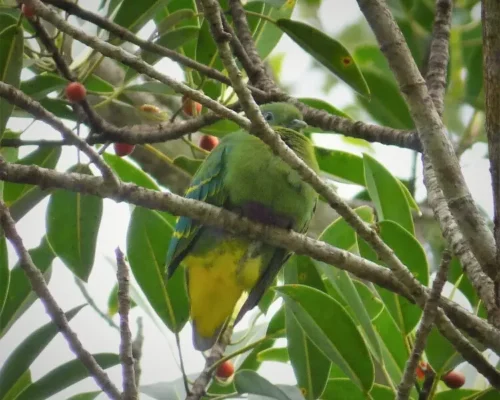In 1953, a vivid green bird with yellow eyerings and wing edgings was discovered on the island of Negros in the Philippines. Dubbed the Negros Fruit Dove, the bird was never seen again. Today, the specimen preserved at the Yale Peabody Museum of Natural History is the only one of its kind. Ornithologists have long debated whether the Negros Fruit Dove is truly its own species, a hybrid, a runt, or even a mutant. “There’s been a checkered history with people hand-waving [its species status] away,” said Richard Prum, a Yale professor of ornithology. Determined to remove the uncertainty surrounding this bird’s status, Prum and John Nash YC ’24 used DNA analysis to unlock the Negros Fruit Dove’s mysteries seven decades after it was first seen.
Prum had been interested in this bird since first arriving at Yale. “In the last twenty years, I probably pitched it five to ten times to my students,” Prum said. In 2021, Nash, an ornithology enthusiast majoring in Ecology & Evolutionary Biology, accepted the challenge.
From 2021 to 2022, Nash worked with Prum to collect tissue samples from toe pads of the Negros Fruit Dove and other fruit doves in the Peabody Museum’s collection. Because the tissue samples had not been frozen, the DNA they contained had fragmented over time. Nash used the ultraconserved elements (UCE) method, a useful tool for analyzing fragmented DNA. This procedure involves an army of minuscule probes that seek out and bind to UCEs in DNA—sections of DNA that are identical between species. The probes, which are made of half RNA and half magnetic beads, latch onto the DNA, after which a magnetic sieve washes away all the DNA molecules that don’t have UCEs. The UCEs are aligned; then, adjacent sequences are compared to characterize relationships between each species. This work culminated in a final phylogenetic tree that contextualized the Negros Fruit Dove in the history of fruit doves in the Phillippines.
“The geologic history of the Philippines is extremely complicated, but the Western Visayas [including Negros] are quite young,” Nash said. The evidence showed that the Negros Fruit Dove is its own species: one that diverged from its most recent common ancestor before Negros Island emerged from the seafloor. Instead of speciating on Negros, the Negros Fruit Dove survives on the island as a relic of a lineage once widely distributed throughout Southeast Asia, with long-distance dispersal events driving early fruit dove evolution.
Evidence also indicated that the Negros Fruit Dove likely thrives in higher altitudes, explaining why ornithologists and hunters, who often stay at lower altitudes, have not reported any repeat sightings. “When you think about how difficult it would be to find a bird that’s only eighteen centimeters long living at the top of a tree, mostly sitting still and picking fruits in a dense rainforest where the trees are upwards of a hundred twenty feet tall—well, that’s a hard bird to find,” Nash said. “Especially if you don’t know what it sounds like, which no one does.”
Nash’s and Prum’s work has put the Negros Fruit Dove on the American Bird Conservatory’s ‘most wanted’ list. By contextualizing the Negros Fruit Dove in its own phylogenetic and biogeographic history, they have demonstrated how a lost species can offer a window into the past.
Image courtesy of Animalia.

